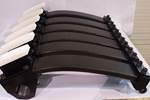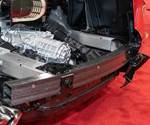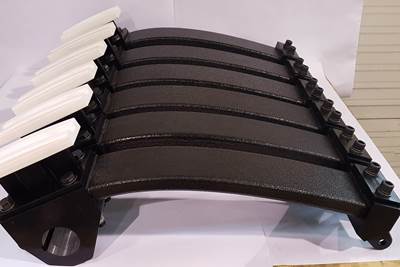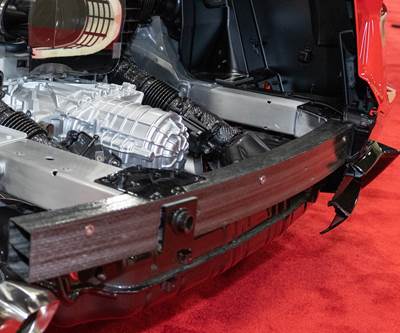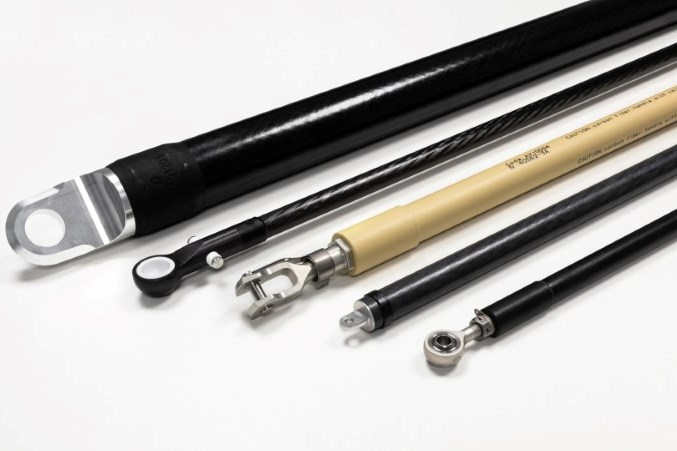
Functionalizing semi-finished pultruded/pull-wound profiles. In searching for low-cost processes to add functionalization to its semi-finished composite profiles and tubes, and to reduce the use of adhesives with its products, Epsilon Composite developed and patented a thermoplastic composite injection overmolding process with its injection molding partner Somocap. Photo Credit, all images (including image in line with title): Epsilon Composite
Epsilon Composite (Gaillan Médoc, France) specializes in carbon fiber/epoxy pultrusion and pullwinding, enabling the manufacture of medium- to large-series, high-performance carbon fiber composite parts, faster and at a lower cost compared to many other processes.
Since its start in the late 1980s, the company has manufactured semi-finished pultruded profiles for a variety of applications in aerospace, industrial and other markets. For many of the end-use parts made from Epsilon Composite’s profiles and tubes — aircraft struts, industrial parts, technical rollers and more — metal or plastic end fittings and inserts are often bonded to them to add functionality or a connection point for other parts.
However, bonding requires the addition of several, often manual, steps: surface preparation, application and curing of the adhesive. This makes adhesive bonding too cost- and labor-intensive for many large-series applications that require thousands of parts per year. Mechanical fasteners can also be used in some cases, but these introduce other challenges as well, such as added weight and assembly steps, and the necessity to machine holes into the pultruded part, which often reduces its mechanical properties.
In 2012, the company began experimenting with alternative methods for adding end fittings or other functionality to components made via pultrusion or pullwinding. “The goal was to find a method that would result in a low-cost, high-quality product, which is kind of the Holy Grail,” explains Alexandre Lull, deputy CEO of Epsilon Composite.
One idea was to use composite injection overmolding as a means for joining a metal end fitting to the pultruded profile. Injection overmolding, using primarily glass or carbon fiber-reinforced thermoplastics, was chosen, Lull says, because of its potential for complementing the low cycle times and high-volume capabilities of the pultrusion or pullwinding process the company was already using.
However, the challenge was that Epsilon’s pultruded profiles are made with epoxy or another thermoset resin matrix, and injection overmolding introduces a thermoplastic matrix, injected under high heat and pressure, with a different coefficient of thermal expansion.
Process development and first prototypes
Epsilon spent the next few years figuring out the best way to implement its ideas for a hybrid thermoset composite pultruded component overmolded with a thermoplastic. For this, Epsilon worked closely with its injection molding partner Somocap (Jatxou, France). “We brought the engineering and composite knowledge, and they brought the injection molding machinery and process knowledge,” explains Ambroise Latron, head of R&D at Epsilon.

Specialists in carbon fiber/epoxy pultrusion and pullwinding. These images show Epsilon’s pullwinding process before (top image) and after (bottom image) cure via a heated die the profile is pulled through.
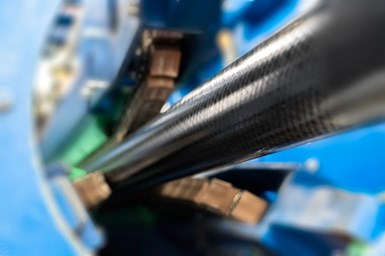
According to the U.S. patent filing in 2021, the process involves several steps: First, a hollow, tube-shaped thermoset composite profile is produced via pullwinding or pultrusion. The end of the profile is then machined to allow for the shape of the end fitting to be attached, which provides a rough surface area for the profile to attach to. Next, a tool/plug is positioned within the profile in the injection machine, and the thermoplastic is then injected, under a specified heat and pressure, around the profile and end fitting, binding them together.
Ultimately, this method can either be used as a way to join a traditional metallic end fitting to the pultruded profile or tube, or the metal can be replaced altogether, and a thermoplastic composite tip can be added via overmolding.
The first demonstrations of the technology involved injecting polyetheretherketone (PEEK) over the top of carbon fiber/epoxy pultruded tubes. “The PEEK is injected at a very high temperature, about 300°C, so we had to make sure that the resin matrix of the [thermoset] composite tube would be able to sustain this temperature for a brief period of time,” says Latron. Through trial and error the R&D team figured out the right combination of a fast injection overmolding process and the required glass transition temperature (Tg) thermoset matrix to produce repeatable results with no damage to the pultruded tube, despite the differences in the materials.
The patent notes, “This method is simple because it may require few steps, but it makes it possible to obtain assemblies that can withstand strong traction, compression, temperature gradients, with materials of different expansion coefficients.”
The original demonstrator parts not only proved feasibility of the process, but exceeded performance expectations, Lull says. This led the company to patent the technology, and to begin introducing it to customers for commercial applications.
Lull notes that a range of materials have been used, from relatively low-cost polyamide 6 (PA6) filled with glass fiber, to higher performance materials such as PEEK, polyphenylene sulfide (PPS) or polyetherimide (PEI) reinforced with glass or carbon fiber. Unreinforced resin systems can also be used if desired.
Compared to other methods like bonding, use of mechanical fasteners or even filament winding over the top of the end fitting, benefits of overmolding are said to include lower cost, weight savings and improved impact tolerance. If metal is replaced by a thermoplastic, corrosion risks can also be eliminated.
This solution can also add sustainability benefits: Chemical solvents and adhesives are removed from the process, plus the use of thermoplastic as a joining method enables the two components to be separated at the part’s end of life (EOL) with the addition of heat, increasing the potential for recyclability. “Plus, there is no scrap in the injection process. Any scraps produced can be melted down into and reused in the injection molding process,” adds Lull.
Commercial applications: Industrial, aerospace, agriculture
After developing and proving out prototypes, the first commercial use case of this technology was in 2015 with a U.S.-based company, manufacturing pultruded rods for use in industrial robotics.
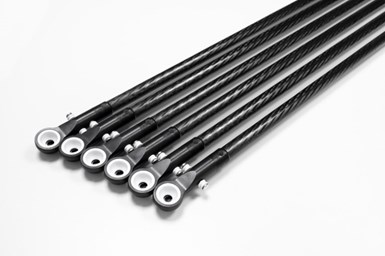
First application: Industrial. One of Epsilon’s core end markets, industrial applications such as arms for machinery or robotics, were the first application of its injection overmolding joining process.
“We worked with industrial clients at first, but the first major business for us was aerospace,” says Lull. In 2018, the company began an R&D project with Airbus (Toulouse, France). This work stemmed from a previous R&D collaboration in which Epsilon had demonstrated its pultrusion technology for manufacturing high-performance tubular structural struts with bonded metallic end fittings. Epsilon successfully demonstrated the performance of the parts and reliability of the manufacturing process up to TRL 6 and Airbus’s internal standards — however, the project did not move on commercially because the structural bonding was considered too risky for critical aerospace structures. To combat these risks, Epsilon developed and patented a process specifically designed to secure the bonding according to aerospace standards, but the process was more expensive, negating the time and cost savings of choosing pultrusion for the struts to begin with.
In the meantime, Epsilon and Somocap developed a new overmolding process and began producing industrial parts commercially. So, for its next R&D iteration of these struts with Airbus, Epsilon introduced overmolding of the end fittings as a solution that met the needs for both optimized cost and high reliability in the parts and process.

Aircraft struts and beyond. After initial successes in industrial and aerospace markets, Epsilon says it uses injection overmolding as a cost-effective, reliable alternative to adhesive bonding for many of its large-scale orders.
Lull explains that an intensive, year-and-a-half-long development process followed, designed to find the right set of parameters and tools to optimally overmold the end fittings onto thermoset composite pultruded tubes. In the end, the struts proved successful and demonstrated a 50% cost savings over traditional composite struts made from filament winding or prepreg. The struts were ultimately qualified by Airbus for commercial use, and Epsilon continues to provide these parts to the aerospace market.
“It’s a big advantage for aerospace in particular,” says Lull. “This technology eliminates the risk of failure for bonding or even mechanical fasteners, and we’ve proven out the process to be able to consistently produce thousands of reliable high-quality parts with no scrap.” He adds that this solution enables parts be reliably and effectively evaluated using nondestructive inspection (NDI) methods that are not able to be used on bonded parts.
Beyond aerospace, the company has also demonstrated the technology commercially with agricultural machinery, working with a customer to replace steel spray boom arms for industrial tractors with 50-meter-wide pultruded composite booms. “The steel booms cannot be as wide, because they are heavier and not as stiff,” explains Romain Coullette, sales director of Epsilon. “Composites are stiffer, lighter and eliminate potential issues with corrosion, so there are many benefits, but productivity is the biggest advantage.” Larger booms enable fields to be sprayed in less time, increasing efficiency.
There are other composite booms on the market; Epsilon’s is a truss-shaped pultruded structure, which Coullette says makes it highly optimized for high stiffness at the lowest weight possible and the least amount of material use, leading to lower overall costs.
This technology has become a go-to solution for Epsilon for large-series parts across end markets. “We’ve been making tens of thousands of parts with zero failure,” says Coullette. “It’s very cost-competitive. Eventually we plan to replace bonding for medium- and large-series parts in all of our end markets.”
Epsilon’s R&D team continues to optimize its overmolding process, to make the overall process and workflow faster and more efficient between pultrusion and injection, and to develop lower cost or modular tooling suitable for small-series applications.
Related Content
Plant tour: Teijin Carbon America Inc., Greenwood, S.C., U.S.
In 2018, Teijin broke ground on a facility that is reportedly the largest capacity carbon fiber line currently in existence. The line has been fully functional for nearly two years and has plenty of room for expansion.
Read MorePlant tour: Joby Aviation, Marina, Calif., U.S.
As the advanced air mobility market begins to take shape, market leader Joby Aviation works to industrialize composites manufacturing for its first-generation, composites-intensive, all-electric air taxi.
Read MoreInfinite Composites: Type V tanks for space, hydrogen, automotive and more
After a decade of proving its linerless, weight-saving composite tanks with NASA and more than 30 aerospace companies, this CryoSphere pioneer is scaling for growth in commercial space and sustainable transportation on Earth.
Read MoreWelding is not bonding
Discussion of the issues in our understanding of thermoplastic composite welded structures and certification of the latest materials and welding technologies for future airframes.
Read MoreRead Next
Automated, continuous processes for high-volume automotive and defense components
Thunder Composite Technologies uses its automated pultrusion, RTM and other processes to produce custom-engineered composite parts for automotive and land defense vehicles.
Read MoreCurved pultrusions enter production
Corvette CFRP rear bumper beam is the auto industry’s first use of new technology.
Read MorePlant tour: Daher Shap’in TechCenter and composites production plant, Saint-Aignan-de-Grandlieu, France
Co-located R&D and production advance OOA thermosets, thermoplastics, welding, recycling and digital technologies for faster processing and certification of lighter, more sustainable composites.
Read More

.jpg;width=70;height=70;mode=crop)
